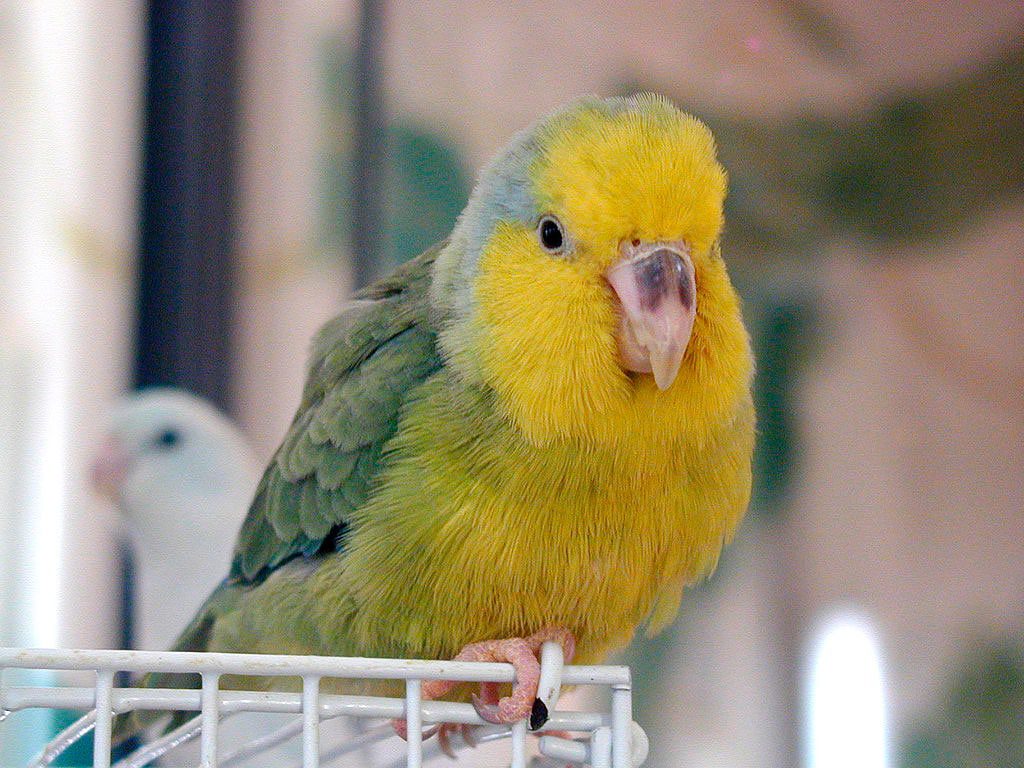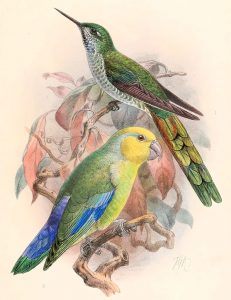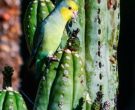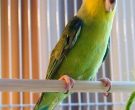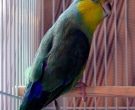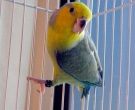Content |
|---|
Description:
14 cm.. height.
The Yellow-faced Parrotlet (Forpus xanthops) is plump appearance and a tail short ending in point. Distinguished by the crown, face, chest and belly yellow, with strong blue patch on the wing , in flight blue occupies almost half of wing . Dorsally gray cafesoso, with the rump blue. Its bill It is ocher.
The female has blue patch on the rump and wings pale smaller.
taxonomy:
Closely related to Pacific Parrotlet (Forpus coelestis); in the past it has been considered a subspecies of this, but there are clear differences in size and color. Monotypic.
- Sound of the Yellow-faced Parrotlet.
Habitat:
The Yellow-faced Parrotlet It Gregaria, He lives in varied habitats, usually arid, riparian forests or gallery in the tropics and subtropics, between 1000 to 1600 m, Although it has been reported to 2745 m.
Reproduction:
Nest in communal area, using tree hollows or sand. The breeding season It is from March to April.
In captivity, They are made of 3 to 6 eggs and up to three broods are raised per year.
Food:
Their diet includes cactus, besides fruit trees. If you know that feeds on Cercidium praecox, paté flowers Bombax discolor and plum fruit Prunus domestica (Begazo 1996, F. Angulo Prato Longo a slightly. 2012).
Distribution:
Extension of the distribution (breeding/resident): 4,800 km2
The Yellow-faced Parrotlet It endemic North Peru in the Valley of the Maranon River, to the south of this country and western Amazon.
Conservation:
State of conservation ⓘ |
||
|---|---|---|
 Vulnerable ⓘ (UICN)ⓘ
Vulnerable ⓘ (UICN)ⓘ
| ||
• Current category of the Red List of the UICN: Vulnerable.
• Population trend: Stable.
• Population size : 350-1500 individuals.
According to the categories of UICN It is considered Vulnerable (VU). Habitat degradation and trade are adversely affecting the population.
Justification of the population
The population It is estimated in 250-999 mature individuals, according to surveys of Begazo (1996) and subsequent recovery of the small-scale. This equates to a total of 375-1,499 individuals, rounded here to 350-1,500 individuals.
The ban on the capture and trade has improved the status of this species. The rate of decline was very rapid in the Decade of 1980, Although at present has been reduced and even stabilized. But, the population is still very small, with records in very few places.
"Yellow-faced Parrotlet" in captivity:
captured for him wild bird trade, It is estimated that 17.000 birds were captured between 1981 and 1994. The rate of mortality during capture is estimated between the 40% and the 100%. Rare and unknown in captivity until 1979-1980.
It´s territorial, temperament quiet, active and initially shy, usually it takes in trust although this depending more on their previous experiences, age, breeding form (by hand creates it naturally).
Notes on captive breeding of Forpus xanthops
Alternative names:
– Yellow faced Parrotlet, Yellow-faced Parrotlet (English).
– Perruche-moineau à tête jaune, Toui à tête jaune (French).
– Gelbmaskenpapagei, Gelbmasken-Sperlingspapagei (German).
– Tuim-de-cabeça-amarela (Portuguese).
– Catita Enana de Cara Amarilla, Cotorrita Carigualda (español).
– Periquito de Cara Amarilla (Peru).
scientific classification:

– Order: Psittaciformes
– Family: Psittacidae
– Gender: Forpus
– Scientific name: Forpus xanthops
– Subpoena: (Salvin, 1895)
– Protonimo: Psittacula xanthops
Yellow-faced Parrotlet images:
Video Carigualda Parrot
Sources:
• Avibase
• Parrots of the World – Forshaw Joseph M
• Parrots A Guide to the Parrots of the World – Tony Juniper & Mike Parr
• Book Parrots, Parrots and macaws Neotropical
• Birdlife
Photos:
(1) – An adult male Yellow-faced Parrotlet perching on the top of its cage by Ruth Rogers [CC BY 2.0], via Wikimedia Commons
(2) – An adult male Yellow-faced Parrotlet photographed at the 2002 AFA convention in Tampa, Florida, USA by Rogers [CC BY 2.0], via Wikimedia Commons
(3) – An adult Yellow-faced Parrotlet photographed at the 2002 AFA convention in Tampa, Florida, USA by Rogers [CC BY 2.0], via Wikimedia Commons
(4) – An adult male Yellow-faced Parrotlet photographed at the 2002 AFA convention in Tampa, Florida, USA by Ruth Rogers [CC BY 2.0], via Wikimedia Commons
(5) – Forpus xanthops Marañon near Canyon Ferry, Cajamarca, Peru by Nick Athanas – Flickr
(6) – John Gerrard Keulemans [Public domain] – Novelty Zoologicae, too.. 2
